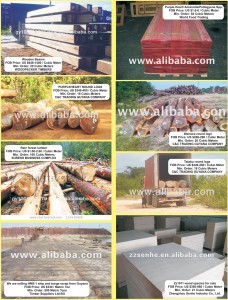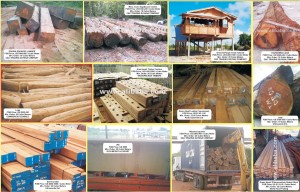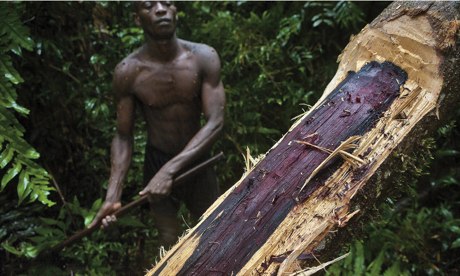Extinction Looms as Notorious Rosewood Loggers Set Sights on Burma Species, Group Warns

A warehouse in Dong Ha , Vietnam, housed hundreds of tons of illegally logged Siamese rosewood. (Photo: EIA)
RANGOON — Burmese tree species tamalan and padauk are disappearing at an extremely rapid pace as Chinese traders have begun targeting their high-value wood, and the species could be logged to extinction in Burma within as little as three years, the Environmental Investigation Agency (EIA) has warned.
Voracious Chinese demand for so-called rosewood species used to make “Hongmu” luxury furniture has set rosewood prices soaring in the past five years, giving rise to an illegal and aggressive trade in Mekong region countries.
In Laos, Thailand, Vietnam and Cambodia, rosewood species have all but disappeared, and the trade has fueled corruption and violence, according to the UK-based group, which said that an investigation into the situation in Burma reveals that Chinese traders have now turned to Burmese rosewood species to supply the Hongmu industry.
“We know from investigating this that padauk and tamalan are next. If the Myanmar government doesn’t move they are going to be in the same situation as Thailand, Laos, Vietnam and Cambodia—Laos already has nothing left,” Faith Dorethy, EIA’s forest campaign team leader, told The Irrawaddy in an interview in Rangoon. “Myanmar is the next frontier in rosewood.”
EIA research of Chinese trade data found that import of tamalan (also known as Burmese tulipwood) and Burmese padauk has skyrocketed in recent years.
Over the period 20
00-2013, China imported 624,000 cubic meters of Burmese rosewoods with a value of US$737 million, but a third of this wood was imported in 2013 alone. “Signs of extreme growth are already showing for 2014,” EIA said, adding that in the first quarter of this year the value of rosewood imports soared to about $240 million, more than double the whole 2012 trade.
The rapid increase in Burmese rosewood imports means that, “Virtually overnight, Myanmar has become the biggest Hongmu log supplier to China worldwide, surpassing more traditional suppliers such as Vietnam and Laos,” the agency said in a briefing provided to The Irrawaddy.
A reported spike in illegal seizures of tamalan and arrests of illegal loggers by Burmese authorities in recent months offered further indications of a rapid increase in the illicit rosewood trade, EIA said. It noted that media reports indicate that logging has “dramatically increased in Sagaing Division.”
Ministry of Environment, Conservation and Forestry data estimates that Burma has stocks of 1.6 million cubic meters of tamalan and 1.4 million cubic meter of padauk, according to EIA. It warned that if Chinese imports continue at 2013-2014 rates, “A realistic timeframe for commercial extinction would be somewhere between 3-13 years. Clearly, there is little room for complacency if these species are to be saved.”
EIA has sent the results of its investigation to the Burmese government and urged it to register tamalan and padauk as threatened species under the Convention on International Trade in Endangered Species (CITES) Appendix III, so that the government can seek technical assistance from CITES to regulate domestic trade. Subsequently, it should seek CITES III listing, which would ban all international trade in tamalan and padauk.
“The first step the government can take is to show political will and engage with the CITES process,” said Dorethy, adding that Burma should also pressure China to ban all import of Burmese logs.
Ba Ba Chor, head of the Myanmar Timber Merchants Association, told The Irrawaddy that the booming rosewood trade “is an open secret,” adding that the deputy environment minister has announced in recent months that authorities confiscated around 15,000 tons of tamalan and padauk.
“So if we can catch 15,000 tons, who knows how much [rosewood] escaped,” said Ba Ba Chor, who added that he only deals in teak and regular hardwoods.

New research by EIA found that Chinese imports of illegally logged Burmese rosewood species is skyrocketing. (Graph: EIA)
He said he supported EIA’s recommendation to list tamalan and padauk under CITES and to pressure China into regulating cross-border timber trade, before adding, “They should be listed as endangered; the problem is that to make the law is very easy, but to implement the law is very difficult.”
Staff at the Ministry of Environment’s Forest Department said senior officials were not available for comment on the EIA report.
Officials have previously blamed lawlessness created by the conflict with ethnic Kachin rebels in northern Burma for the rampant timber trade, but claimed that the recently formed Forest Police Department was successfully cracking down on illegal logging in many parts of Burma.
Burma’s reformist government has indicated that it is willing to reduce deforestation and regulate the timber industry. Beginning April 1, it banned the export of raw logs and allowed only sawn wood to be exported.
Rare Woods Sought After in China
EIA has earlier spoken out against the clear-cutting of hardwood species in Burma, such as teak, through illegal logging, logging concessions and expansion of plantations. This has been occurring on a massive scale in northern Burma in the past decade, with an estimated $5.7 billion worth of timber smuggled overland into China from 2000 to 2013 through unregulated trade, the agency said in March.
The rosewood trade is different in that the high-value species grow among other trees in the forest and are located by local villagers and brokers, after which loggers come to take out individual trees.
The brownish-red rosewood is prized in China for crafting traditional Hongmu furniture. This Qing and Ming dynasty-style furniture disappeared during the Cultural Revolution, but in recent years replicas have become a status symbol among China’s nouveau riche who pay hundreds of thousands of dollars for Hongmu sets made from the increasingly rare wood.
Dorethy said illegal rosewood trade was proliferating throughout the Mekong region “because of the Hongmu industry and the fact that they have a standard of species that qualify as Hongmu—those species are what traders, companies and loggers are going for.”
The Hongmu industry, which according to EIA enjoys Chinese state support, identifies 33 rosewood species from across the globe as suitable for crafting furniture. Six species are from Burma, and tamalan and padauk are the most sought after.
Tamalan is mostly found in Sagaing Division, and to a lesser extent in Shan and Kachin states, and Mandalay Division. Padauk is concentrated in Shan State and found in Magwe, Mandalay and Sagaing divisions.
Soaring Prices, Violence and Corruption
With declining rosewood stocks in the Mekong region and strong Chinese demand, prices for tamalan and padauk have risen sharply in Burma, and as brokers search for increasingly rare trees, impoverished villagers are being sucked into the trade, according to local timber traders.
A trader, who asked not to be named, said, “Actually most of the trade is in tamalan. Padauk is very rare, we don’t have much padauk anymore. In [Kachin State] if a villager found a padauk tree, they can get $50 or $100 just to show the location of the tree.”
He said tamalan was being sold in Kachin State “at seven times the price of teak,” which would constitute prices of between $10,000 to $15,000 per cubic meter, a fortune in the impoverished communities of northern Burma.
EIA said criminal gangs run by Chinese traders influence the supply chain down to village level, while authorities, border officials and rebel groups are taxing or taking bribes to allow the lucrative trade.
Ba Ba Chor, of the Myanmar Timber Association, said, “It’s a long route from the forest to the border, so you can imagine that all are involved—security persons, administrative persons, all are involved. Local traders, also the army, the KIA [Kachin Independence Army], Chinese traders. It’s kind of a mafia business.”
Dorethy said Burmese rosewoods were being logged unsustainably and without government permits and trucked into China’s Yunnan Province, despite the fact that Yunnan authorities officially instated a log import ban in 2006 and in violation of Burma’s log export ban from April this year.
She described the rapidly expanding rosewood trade in Burma as “a crisis” and said, “The consequences are not just environmental but also social.
“Right now, the number one species [demanded by Chinese traders] is Siamese rosewood, there is about two or three years left and with that comes an increasing violence towards park rangers and villagers—it’s a war zone in Thailand’s forests right now.”
“In Thailand, villagers are being paid in yaba [to log] by brokers,” she said, referring to the local term for methamphetamine tablets. “There have been dozens of killings of Cambodian loggers crossing into Thai forests, and there has been an increase of Thai rangers getting killed trying to protect the last trees.”
She added that the government should be “more transparent” about the problem of large-scale rosewood logging, adding that auctioning of seized tamalan and padauk stocks had been shrouded in secrecy.
“So how do we know that the companies that are involved in illegal logging are not the same companies buying up the timber through these auctions?” Dorethy said.
Exotic, pricey wood species being shipped out of Guyana
As the controversy surrounding Bai Shan Lin’s operations in Guyana continues, the main question is  why the company is exporting large quantities of exotic woods such as “Locust and Wamara”.
why the company is exporting large quantities of exotic woods such as “Locust and Wamara”.
Conservationists have been arguing that countries where these “exotic” woods are found should not export large quantities since they are considered an “invasive species”.
Invasive species, also called invasive exotics or simply exotics, is a nomenclature term and categorization phrase used for flora and fauna, and for specific restoration-preservation processes in native habitats, with several definitions.
Sometimes called Guyana Rosewood for its lustrous, dense, and colour, Wamara technically isn’t true rosewood (Dalbergia genus), but is in what could arguably be viewed as one of the most under-appreciated genera of tropical hardwoods: Swartzia.
This genus is filled with a variety of colorful and striped woods, most of which remain obscure. It is considered an “exotic wood” in many parts of the world.
The Locust tree is native to the southeastern United States, but has been widely planted and naturalized elsewhere in temperate North America, Europe, Southern Africa and Asia and is considered an invasive species in some areas.
Pricing for the species…
Bai Shan Lin on July 2009, last, exported 558 pieces of Locust Sawn Timber from Guyana.
In October 2009, the company also exported Wamara Sawn Timber. A total of 5303 pieces were sent out in two  containers. World Market demand for these two species of wood could fetch a heavy price. The “Wamara” which is being sold by the cubic meter can fetch a price of between US$200 and US$600.
containers. World Market demand for these two species of wood could fetch a heavy price. The “Wamara” which is being sold by the cubic meter can fetch a price of between US$200 and US$600.
Kaieteur News was told that the “Wamara” logs can be sold from between US$260 and US$290. Depending on the demand, the prices can triple, making it one of the best selling timber products being exported.
It is believed that Bai Shan Lin and other logging companies have not been declaring “Wamara and Locust” when exporting. Rather they have been passing this off as mixed hard woods.
Several sources within the Ministry of Natural Resources have said that the Wamara business is among the most lucrative business ventures that Bai Shan Lin is currently involved in.
This newspaper was also told that low level ministry workers along with forestry officials who are tasked with monitoring the export of timber are not able to complete their task. It is being reported that since Bai Shan Lin along with several others entered into joint ventures, it has been “almost impossible” to keep a tab on how much timber is being exported from Guyana.
Bai Shan Lin, a Chinese logging company, has big plans for Guyana: forest concessions covering 960,000 hectares; a 20-kilometre river gold mining concession; a 500-hectare Guyana-China Timber Industry Economic and Trading Cooperation Park and a 160-hectare real estate development.
Despite the scale of the planned operations, Bai Shan Lin’s agreements with the government of  Guyana are not public and there has been no discussion in the National Assembly about the company’s plans.
Guyana are not public and there has been no discussion in the National Assembly about the company’s plans.
In Guyana, it is illegal for a logging company to take over another logging company’s operation, unless officially authorised by the President. Yet Bai Shan Lin has managed to enter into large scale joint ventures with a number of locals.


![Expertvoices_02_ls_v2[2]](http://i.livescience.com/images/i/series/5/original/ExpertVoices_02_LS_v2[2].jpg?1362601053)



